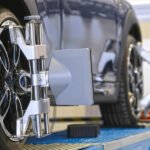

Demystifying the Exhaust Muffler: A Deep Dive into Your Car’s ” Silencer “
Nestled inconspicuously in the shadows, the exhaust muffler quietly takes on the role of an unsung hero in every car. It’s more than just a metal can hanging at the tailpipe; it acts like a maestro, skillfully transforming the tumultuous noises of the engine into a civilized and mellow hum. Beyond its musical prowess, the muffler serves as a silent guardian, ensuring that the air stays clean and functioning as a protective shield for your eardrums and those of everyone in the vicinity. Let’s delve into the captivating realm of mufflers, unravel their mysteries, and gain a deeper appreciation for the indispensable role they play in our automotive journeys.
Functioning Symphony:
The exhaust muffler takes on a crucial mission: quieting down the powerful rumble of the engine. The engine’s symphony of explosions in its cylinders creates pressure waves that, if left unchecked, would result in a loud and chaotic barrage of sound. That’s where the muffler comes in – it acts like a sound engineer, skillfully reducing and redirecting these waves to produce a more soothing and less ear-piercing melody.
Anatomy of the Muffler:
Within this modest metal enclosure resides a carefully composed orchestra of components. Perforated pipes, typically ranging from 7 to 10 in number, function as the instruments, enabling sound waves to enter thoughtfully positioned chambers. Baffles, commonly crafted from materials like stainless steel or fiberglass and measuring approximately 0.5 to 1.5 inches in thickness, serve as sound barriers. They adeptly reflect and absorb the waves, contributing to the muffling process. A complex network of tubes intricately directs the subdued sound and exhaust gases toward the tailpipe, ensuring a seamless flow.
Silencing the Roar:
The underlying science behind the muffler’s ability to silence the engine noise is deceptively simple yet ingeniously effective. Comparable to the way ripples in a pond can be counteracted by opposing ripples, the muffler capitalizes on this principle. Within its chambers, it orchestrates the creation of opposing sound waves, cleverly nullifying the thunderous roar of the engine before it escapes into the external environment. The distinctive arrangement of chambers and baffles within the muffler isn’t just happenstance; it plays a pivotal role in determining the muffler’s unique sound signature. This can range from a deep, resonant rumble to a nearly silent purr, offering a spectrum of auditory experiences.
Myth Busters:
Mufflers often find themselves surrounded by misconceptions. Contrary to some beliefs, swapping out your muffler won’t mysteriously gift your car with additional horsepower, although it’s worth noting that certain performance-oriented mufflers might yield a modest power gain. Additionally, the notion that bigger is invariably better doesn’t hold true in the world of mufflers. Opting for an excessively large muffler can impede engine efficiency and potentially lead to back pressure issues, illustrating that when it comes to mufflers, the mantra of size doesn’t necessarily equate to superior performance.
Muffler Maintenance 101:
Taking care of your muffler is surprisingly simple. Regular inspections for rust, leaks, or loose parts are key. Avoid overloading your car, as extra weight can put strain on the exhaust system. And let’s not forget the basics: avoid aggressive driving and give your car occasional “blowouts” by revving the engine momentarily under safe conditions to clear out any accumulated carbon deposits.
Conclusion:
The exhaust muffler holds a pivotal position in shaping our driving experience. It not only guarantees the seamless operation of the engine but also serves as a guardian for our ears and the environment. Beyond its functional aspects, the muffler even contributes to the unique personality of our vehicles. Therefore, the next time you embark on a journey, take a moment to silently appreciate this diligent hero – the muffler, the conductor orchestrating automotive harmony.
Add a comment Cancel reply
Categories
- Car Gadgets (17)
- Car News (33)
- Car Reviews (43)
- Car Wars (7)
- Mechanicals (32)
- Uncategorized (2)
Recent Posts
About us

Popular Tags
Related posts


Essential Car Repair Skills Every Driver Should Know

All About Wheel Balancing








